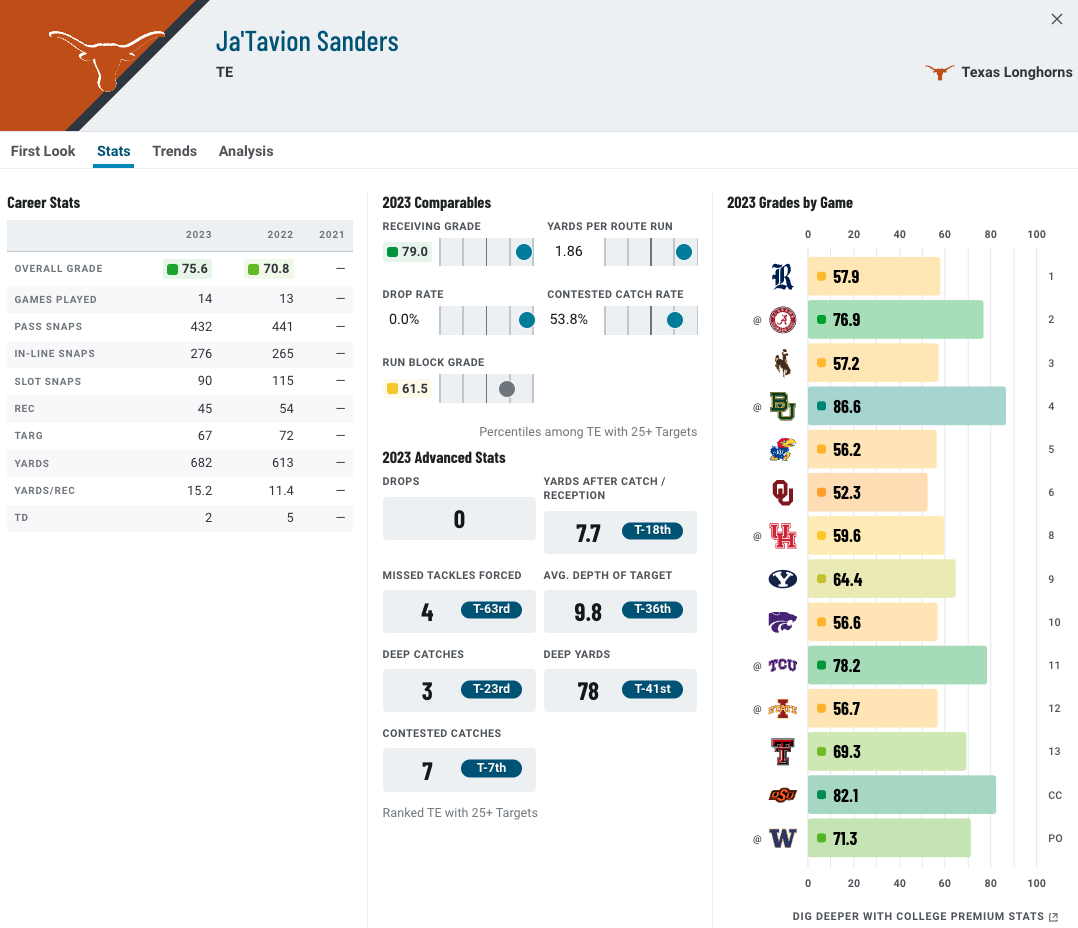The 2024 NFL Draft is fast approaching. The PFF big board is live, mock draft season is in full swing and the 2024 NFL Scouting Combine has wrapped up.
This year’s tight end class is led by Brock Bowers, one of the most productive college tight ends we’ve ever graded. Bowers should be a top-10 pick, but after that, there’s a decent gap between him and TE2. Ja'Tavion Sanders and Erick All could be called in the second round, and players such as Cade Stover and Ben Sinnott could be solid depth options for the middle rounds.
Let's look at Texas‘ Ja’Tavion Sanders, who finished his college career with two straight seasons with 45-plus receptions and 600-plus receiving yards.
Click here for more draft tools:
2024 Mock Draft Simulator | 2024 Big Board | 2024 Draft Guide
2024 Player Profiles | 2024 Mock Drafts | NCAA Premium Stats
SCOUTING SUMMARY
Sanders, a former five-star recruit, looks like a super-sized athlete. Mainly coming from an in-line or wing-back position, he is a constant vertical threat and a mismatch for most linebackers in coverage. His hands are reliable, as he did not drop a single pass in 2023. His explosive movement skills allow him to run routes like a receiver.
If he hadn't been on a team that also included Adonai Mitchell, Xavier Worthy and Jordan Whittington, he could've easily been a 1,000-yard receiver. He possesses all the tools to be an impact blocker, as well.

WINS ABOVE AVERAGE
WAA represents the number of wins a player is worth over an average college football player and is a metric that evaluators can utilize to assess performance. It combines how well a player performed in each facet of play (using PFF grades) and how valuable each facet is to winning football games.
The result is a first-of-its-kind metric that allows for cross-positional valuation and predicts future value at the player and team levels.
HOW SANDERS RANKS IN THE STABLE METRICS
Receiving grades are relatively stable from year to year, but there is always some level of dependency on quarterback play when evaluating receivers. Isolating receivers against single coverage versus zone is informative, as it shows how much was earned in one-on-one situations compared to more scheme-driven production. Advanced data shows how open receivers are on their targeted routes, and separation percentage is one way to isolate the receiver away from his quarterback.
As far as advanced stats go, yards per route run (YPRR) is one of the best measures of a wide receiver’s production, as it takes into account how well he takes advantage of his opportunities. Average depth of target (aDOT) and yards after the catch per reception are informative about a receiver’s usage pattern, and his after-the-catch expectations are directly affected by how far down the field he is targeted. Both numbers are as much about style as they are about production.
In the run game, positively graded blocks are more stable than negatives from season to season.
Sanders moves extremely well for a guy who measured in at 6-foot-4 and 245 pounds at the NFL combine. The Texas tight end produced 38 receptions of 15 or more yards over the last two years, second to only Brock Bowers.
But unlike Bowers, Sanders lined up as an in-line tight end on almost 75% of his career snaps. His reliability is also very impressive, as he’s dropped only four passes across 139 career targets.
BOTTOM LINE FROM PFF's 2024 NFL DRAFT GUIDE
Sanders is a Tier 1 athlete for the tight end position. He is still mastering the nuances of tight end play, and he needs more of a mean streak consistently as a blocker.
However, even with those concerns, what he brings to the table as a vertical threat is worth a top-50 pick.





 © 2024 PFF - all rights reserved.
© 2024 PFF - all rights reserved.